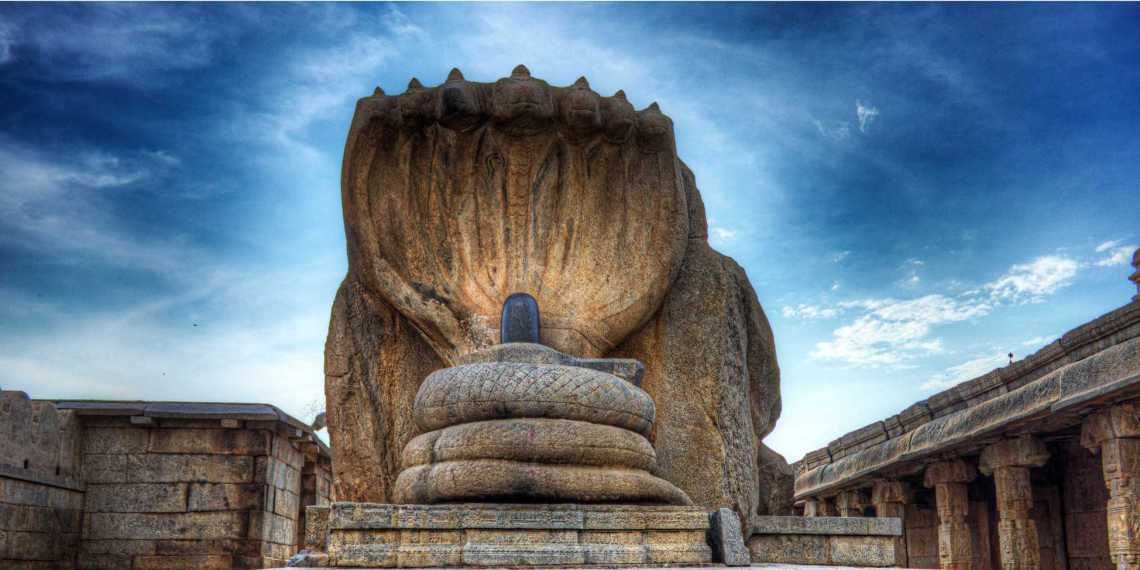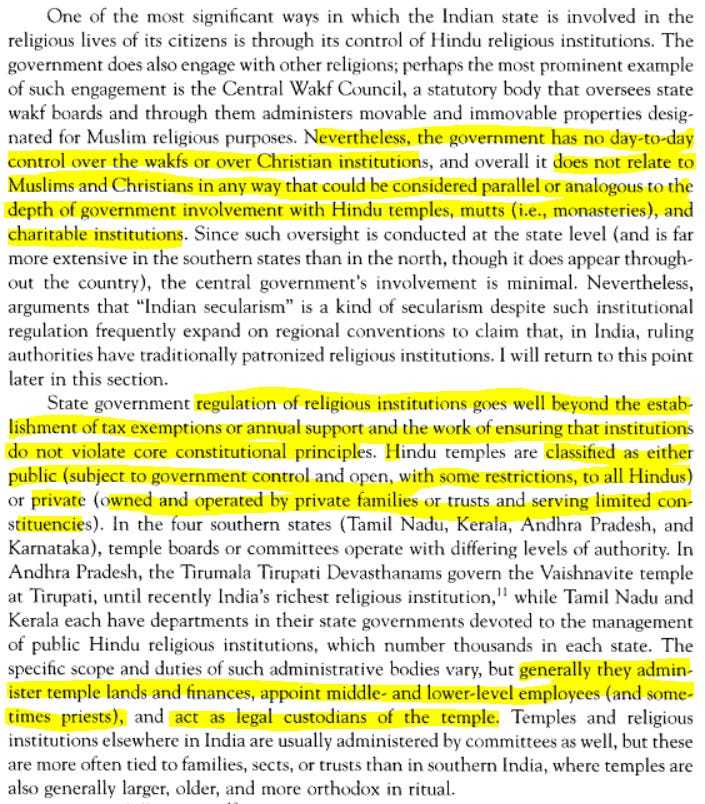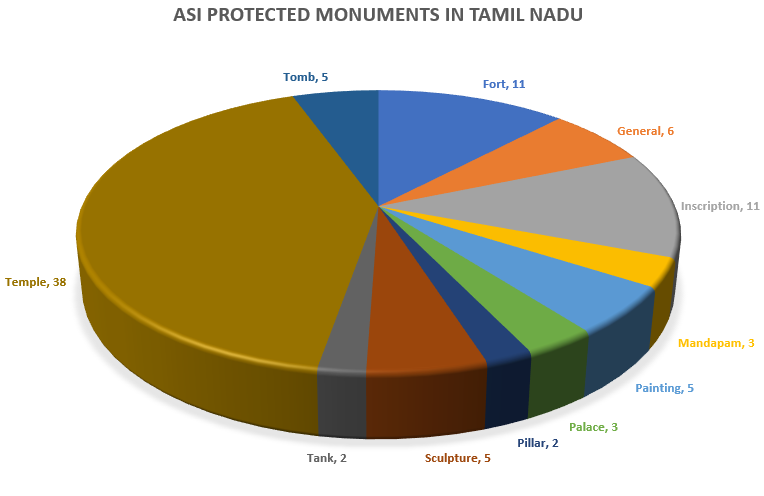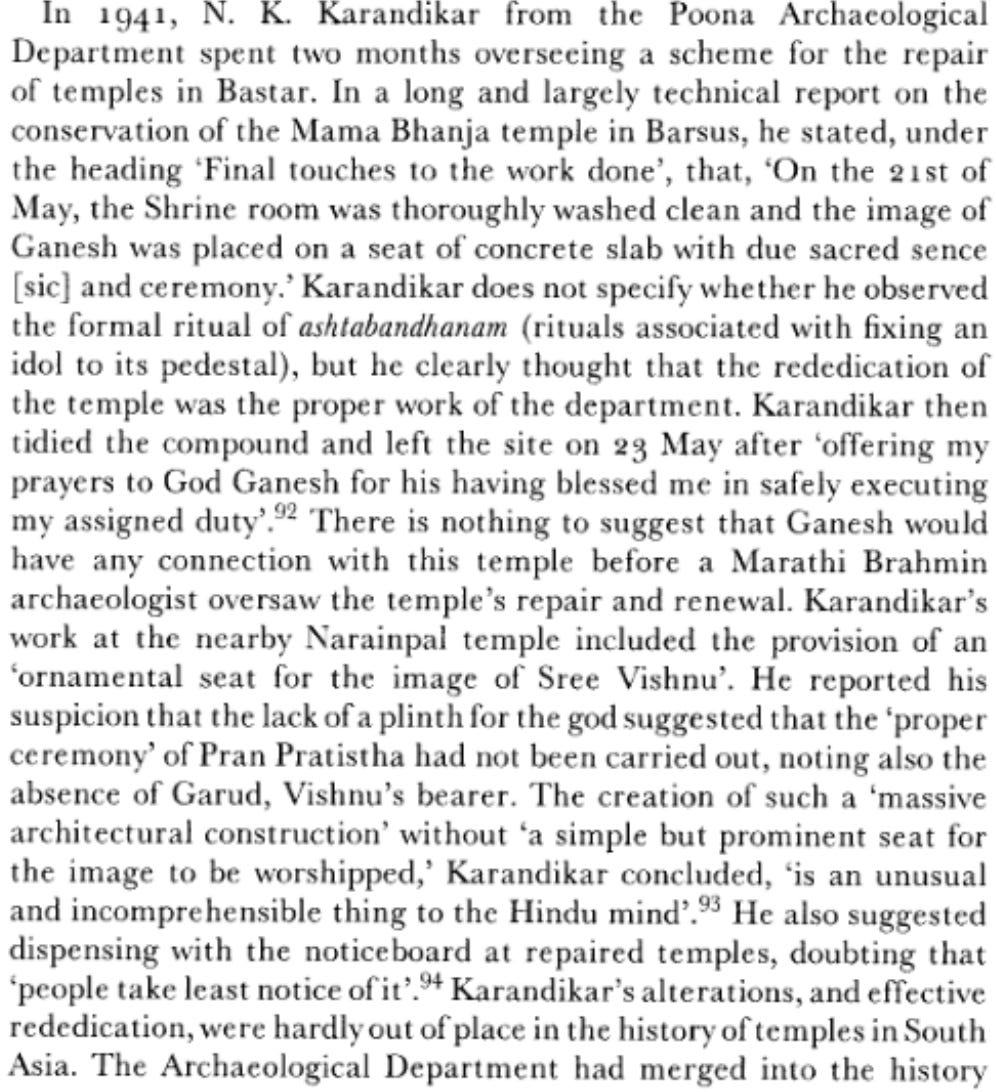Insightful newsletter of Drishtikone: Issue #267 - Free the Temples!
Secularism in India is a tool to destroy the heritage of Hindus. What was started by the British in terms of plunder was furthered by the latter state governments. It is time to liberate the temples!
Flickr – the image is of Veerbhadra temple at Lepakshi. The imposing Shiva Lingam is carved out of a natural boulder to the west of the shrine, this seven-hooded Naga shelters a black-polished lingam cradled in its ribbed coils. A saptamatrika panel is placed below to the right. The temple was consecrated by Sage Agasthya when he stayed in this place.
“Killing myself was a matter of such indifference to me that I felt like waiting for a moment when it would make some difference.” ― Fyodor Dostoevsky, The Dream of a Ridiculous Man
In the year AD 532, Damascius left Athens along with seven other philosophers from the most celebrated of the Greek schools – the Academy. These wise men traced their lineage to the illustrious Plato himself.
Brilliant, ruthless, stern, and intelligent Damascius was all but 70 years old as he led the group to the world unknown outside of the Roman Empire. “Men tend to bestow the name of virtue on a life of inactivity. But I do not agree.. the learned who sit in their corner and philosophize at length in a grand manner about justice and moderation, utterly disgrace themselves if they are compelled to take some action, “ he would say. An attitude that was needed at that time.
For, in those days, the Christian emperor Justinian I (also known ironically as “Justinian the Great” and even Saint Justinian!!) ruled. And he was a wretched tyrant who destroyed more of the Greek art, science, and culture than anyone in history!
His soldiers would enter the homes of people to search for books and artifacts that were religiously blasphemous. If found, they would be burned and destroyed in public squares.
Temples across the Roman empire were being broken down and torn apart. The statues were smashed and treasures were melted.
Christian preachers were teaching their congregations to “hunt down sinners and drive them into the way of salvation as relentlessly as a hunter pursues his prey into nets”.
Liberties were gone. Temples destroyed. Books burnt. Philosophers and learned killed.
As Damascius lamented about how their collective way of life was being “swept away by the torrent.”
When your very way of life is destroyed by rabidly fanatic religious bigots, they not just destroy a few gods and buildings. They destroy an entire civilization and the collective intelligence of mankind. What was lost by human scientific and art advancements when Christians destroyed the Greek civilization has still not been recovered! That is the real loss!
Desecration of Temples by State in “Secular” India
Deepa Das Acevedo argues in her paper titled “Secularism in the Indian Context” published in Law & Social Inquiry (Vol. 38, No. 1 (Winter 2013), pp. 138-167) that even though the government has some role in the oversight of the Wakf Boards, the involvement in the Hindu temples, mutts (monasteries) and charitable institutions goes far deeper. (Source)
The saga of the capitulation of the temples started very early after the conquest started by the East India Company.
On September 18th, 1803 East India Company launched an attack to occupy the province of Cuttack - which happened in 14 days. The Peshwas who were ruling Orissa were driven out per Lord Wellesly’s orders conveyed to Lieutenant Colonel Lionel Campbell, Northern Division of Madras Army on August 8, 1803.
An account of Brij Kishore Ghose, Head Clerk of Cuttack published in 1848 suggested how the priests of Puri did not care for how the temple was taken over by the British.
On 15th September, (1803) “a deputation of venerable white-robed Brahmins,” waited on victorious Lieutenant Colonel Harcourt and “begged that the religious key to the province might be placed under the protection of the British. The possession of the god had always given the dominion of Orissa.” On September 18 Company army encamped within “the shadow of temple walls.” [2] The Lord of the Universe, as Jagannath is fondly hailed, chose His own master, alas! a foreigner. Letter of September 26 Melville, who was Commissioner of affairs of Cuttack to the Governor-General brought the most desirable news that “the Temple and the town of Jagannath are placed under the happy protection of the British army...” [3] Jagannath’s surrender was preceded by a ritual. (Source)
The regulating of the temples by law started in the right earnest in Bengal from 1810.
Regulation XIX of Bengal passed in 1810 and a similar one in Bombay in 1827.
A regulation was passed in Madras which was said to be “compiled from the Regulation XIX of 1810 of the Bengal Code”. (Source) This was the Regulation VII of 1817.
Considerable endowments have been granted in money, or by assignments of land or of the produce of the land by the former Governments of this country as well as by the British Government, and by individuals for the support of mosques, Hindu temples, colleges and choultries, and for other pious and beneficial purposes; and … endowments [are] in many instances appropriated, contrary to the intentions of the donors, to the personal use of the individuals in immediate charge and possession of such endowments; and… it is the duty of the government to provide that such endowments be applied according to the real intent and will of the granted. (Source)
The British were administering Tamil Nadu for 150 years as the Madras Presidency. At that time the Board of Revenue took charge of the temples and their endowments.
The strategy to take over the temples was very simple. If the District Collector even “discovered” that the funds were misused at a temple (his discretion), the temple could be taken over by the state.
In practical terms the Board, based on the recommendations of the District Collectors, appointed and supervised the work of the temple trustees. If it was “discovered” that the temple endowments were “misused”, the collectors had the powers to “take over” the temple management. And the cost of all this “administration” was the first charge on the endowments made to the temples in each district. (Source)
This started the slide for the Hindu community.
The Hindu Religious and Charitable Endowments Department under the Government of Tamil Nadu manages and controls the temple administration within the state. It is done so under the Tamil Nadu Hindu Religious and Charitable Endowments Act XXII of 1959.
In 1923, Madras Hindu Religious Endowments Act was passed by Madras Presidency. In 1925, the Government constituted "The Hindu Religious and Charitable Endowments Board" consisting of a President and two to four Commissioners nominated by the Government to function as a statutory body. Subsequently, it was modified and in 1960 it became The Hindu Religious and Charitable Endowments department by Tamil Nadu Hindu Religious and Charitable Endowments Act XXII of 1959 which came into force with effect from 28 April 1960. (Source)
What do they manage?
The numbers are mind-boggling: 36,425 temples, 56 mutts or religious orders (and 47 temples belonging to mutts), 1,721 specific endowments, and 189 trusts.
Some of the temples this government department runs are:
Annamalaiyar Temple, Tiruvannamalai
Meenakshi Amman Temple, Madurai
Palani Murugan Temple, Palani
Ramanathaswamy Temple, Rameshwaram
Marundeeswarar Temple, Chennai
Ranganathaswamy Temple, Karamadai, Coimbatore
Jalakandeswarar Temple, Vellore
Baghavathiamman Temple, Kanyakumari
Thanumalayaswamy Temple, Suchindrum
Sri Ranganathaswamy Temple, Srirangam
Those are some of the largest temples in the state.
Even when the State governments masquerade these laws as ways to help manage the temples, the fact is that the donations from the devotees have been usurped by the government to play their own vote bank politics.
In Karnataka, for example, the funds from the donations collected in Karnataka temples were diverted to subsidize Mosques, Madrasas, and Haj Committee and also to bolster the state funding of Churches and Christian Institutions.
disbursements to temples in Karnataka for renovation and maintenance between the period ’97-’98 to ’02-’03 fell (more than halved) from Rs 16.5 crores to Rs 7.1 crores even as revenues collected from temples rose from Rs 58.63 crores to Rs 79 crores! Interestingly, over the same period, disbursement to Madarsas, Mosques and Haj committee rose more than 4 times from Rs 14.25 crores to Rs 58 crores and disbursement to Christian institutions and churches more than doubled from Rs 5 crores to Rs 12.75 crores. (Source: TOI)
Other cases of the egregious heavy-handed anti-Hindu role of the state governments have been documented in almost every state - Andhra pradesh, Tamil Nadu, Orissa. (Source: TOI)
In 2009, even as the governing body of Tirumala Tirupati was facing questions over 300 missing gold coins, a priest was arrested after confessing to stealing a deity’s two gold necklaces weighing more than a kilo. Governing body officials “said the priest was only a small fry and that there was a larger scam happening at the Lord Balaji temple – which is in possession of jewellery worth more than Rs 45,000 crore”. No inventory of the temple assets, controlled by the government, has been done since 2005. An inquiry in July 2008 by the Vigilance Department of TTD resulted in the suspension of several officials but the findings were never made public.
In 2010, the state government of Orissa apparently sold several hundreds of acres of land belonging to Jagannath Puri temple to Vedanta Foundation at throw-away prices. The matter is now under investigation.
In 2003, the Telugu Desam government in Andhra Pradesh “offered ayurvedic giant Dabur as much as 120 acre of land for a monthly lease of Rs 5,833”. The land belonged to Kodanda Rame Swamy temple in Chittoor.
In Tamil Nadu, an audit in 2007 of the ancient Parthasarathi Temple in Chennai, managed by the government, revealed that records of seventeen temple grounds (~41000 sq. ft.) in T.Nagar were missing; In addition 11 other grounds had incomplete records and lacked clear titles. The audit also found properties that were let out to non-existing tenants & those that were sold apparently on an ad-hoc basis.
The point is clear - the state governments have been misusing the funds that are collected in the temples.
How the Archeologists destroyed the Ancient Temples
But the attack was not just from the standpoint of managing the temples, but the attack was also mounted with total control of what happened to ancient temples using the Archeological Survey of India. The very Hindu community for which these temples were built, was thrown out of the ancient powerful temples by the government as any worship ritual was considered a violation of the protected “monument.”
The Ancient Monuments Preservation Act, 1904 was passed on 18, March 1904 by British India during the times of Lord Curzon as the Viceroy. What powers did it provide to the government?
preservation of ancient monuments, for the exercise of control over traffic in antiquities and over excavation in certain places, and for the protection and acquisition in certain cases of ancient monuments and of objects of archaeological, historical or artistic interest. (Source)
The government could control the “traffic” and also decide what was to happen to that “monument” for it got complete control over those “monuments.”
Let us go into the powers that the Government had under this act.
Traffic in Antiquities
Power to Central Government to control traffic in antiquities.
Protection of Sculptures, Carvings, Images, Bas-Reliefs, Inscriptions or like objects
Power to Central Government to control moving of sculptures, carvings or like objects.
Purchase of sculptures, carvings or like objects by the Government.
Archaeological Excavation
Power of Central Government to notify areas as protected.
Power to enter upon and make excavations in a protected area.
Power of Central Government to make rules regulating archaeological excavation in protected areas.
Power to acquire a protected area.
General
Assessment of market value or compensation.
Jurisdiction.
Power to make rules.
Protection to public servants acting under Act.
Isn’t it strange that you find everything in terms of sculptures etc? Were there no “protected monuments” which were Churches or Mosques that the government took over?
Well, when you look at the list of the monuments under the Archeological Survey of India, specifically the state governments, you realize that the monuments - other than the forts and some tombs - are entirely from the Hindu community. And, just the Hindu community!
So, all those powers - to “traffic in antiquities” and “purchase of sculptures” etc-were only with respect to the religious structures of the Hindus. Let us take a look.
Based on the data on the Government of Tamil Nadu’s Department of Archeology, here is a quick distribution of the types of monuments that the government’s archeological department manages. (Source)
Why is this such a dangerous thing? The Archeologists have no duty to report thefts that occur in the monuments under the ASI supervision. And these thefts are not just isolated incidents, but as per the survey of 15,000 archeologists in India, this “looting” is frequent, iterative, and widespread! In short rampant and relentless.
Worse, a quarter of those archeologists did not even give a rat’s arse about the looting! Around 2/3rds simply notified the local law enforcement authorities who are anyway mixed up with the traffickers or their own office.
The policy brief draws insight from a global survey on why many field archaeologists say they do not report looting in archaeological sites when they encounter it, and argues that the duty to report should be a central tenet of a field archaeologist’s professional ethics. Some of the startling results that actually supported our long-held claim was the result of the survey in which nearly 15,000 archaeologists took part: Not only did 80% state they had experienced first-hand encounters with looting, they also noted that these were not isolated encounters—i.e. looting is frequent, iterative and widespread. What did they do when faced with such looting? The survey says nearly 15% of archaeologists documented it internally, 25% took no action, while 62% did notify external agencies including archaeological authorities or law enforcement. (Source)
That is the level of neglect that the ASI “experts” have for the “protected monuments” which are predominantly Hindu temples or murtis.
While the archeologists - through neglect and in some cases even wilful participation of the workers on the ground - destroyed many temples, sometimes the temples’ real energy was destroyed with wonderfully good intentions.
Ancient temples have been consecrated by some of the greatest of Rishis. But in the hand of ASI “professionals”, it just became like the local neighborhood temple.
So, what recourse do the Hindu Indian citizens have? Let us see how the courts have handled this issue.
State control of the temples and the Courts
On 6th January 2014, in Dr. Subramanian Swamy & others vs. State of Tamil Nadu & others – also known as the Chidambaram Temple Case, the Honorable Supreme Court of India had quashed the appointment of an “Executive Officer” by the Tamil Nadu Government for Sri Sabhanayagar (Sri Nataraja) Temple in Chidambaram. The court said in its order:
“Even if the Management is taken over to remedy the evil of mismanagement, it must be handed over immediately after the evil is remedied. Therefore, the management by State can only be for a limited period, failure to prescribe the duration in the impugned order would make it liable to be set aside...” (Source)
It however took 8 months for the state government to remove the illegal hundis and the snack stall at the premises.
Even though the law of the land, given the Supreme Court judgment was clear, and the Chidambaram temple was freed from the government, things did not end for the discrimination against all the temples in the state!
In September 2020, the Madras High Court refused to even entertain the petition challenging the validity of the discriminatory Tamil Nadu Hindu Religious and Charitable Endowments Act.
The Madras High Court on Thursday refused to entertain a plea challenging the constitutional validity of the Tamil Nadu Hindu Religious and Charitable Endowments Act. The petitioner Arjunan Elayaraja claimed that the Act was discriminatory as it only controls places of worship of the Hindu religion and not others. He also claimed that the Act curtailed worshipping rights of Hindus, while rights of people following other religions are not curtailed. The first bench of Chief Justice AP Sahi and Justice Senthilkumar Ramamoorthy rejected the claims and suggested the petitioner withdraw the plea and come up with a better petition if required. The bench observed that management of temples has nothing to do with the right to worship. One can worship as much as they want. (Source)
What?!! Seriously?
It almost seems as if the Tamil Hindus have to fight for the freeing of every temple one by one because somehow the Madras High Court does not much care for the Supreme Court judgments anymore.
In 2019, when a PIL was filed about the mismanagement of the Jagannath Puri temples, the Supreme Court was very clear about its intentions.
Referring to the apex court’s 2014 order by which administration of 1,500-year-old Nataraja Temple at Chidambaram was taken out of control of Tamil Nadu government, a bench of Justices S A Bobde and S A Nazeer said it will consider that verdict while deciding on the issue of administration of Jagannath temple in Puri. (Source)
So now it is left for the citizens to find other ways out.
And, that is where Sadhguru’s “Free Hindu Temples from Government Control” campaign comes in. Now, the only way things will change in the state is for the citizens to clearly state what they want from the next government so the parties can add that in their promises. And later hold them accountable.
market corner: 10 quick bytes
India among top-performing markets in FY21; investors’ wealth swell by Rs 94 lakh crore - more
Jewar Airport: UP cabinet approves proposal to acquire 1,365-hectare land for upcoming Noida International Airport - more
India considers net-zero (zero out its greenhouse gas emissions) goal around 2050, a decade before China: Report - more
Maharashtra accounts for 61% of daily Covid-19 cases - more
China’s Shunwei Capital exits Koo’s parent; sells stake to Kalyan Krishnamurthy, Nikhil Kamath, others - more
China opens, then shuts, door for Indians looking to return - more
Necessary action was taken against e-commerce companies for alleged FDI policy violation: Piyush Goyal - more
Govt to bundle loss-making, profitable airports for sale - more
Govt forms experts committee for Startup India Seed Fund Scheme - more
Non-govt PFs investing in AIFs will add to MSMEs’ fundraising options, mobilize domestic capital: Experts - more
nota bene
Targeted for Religious Freedom: Ditched by family, ostracized by his community and censured by a string of senior BJP leaders and those from other political parties, former chairperson of Shia Waqf board Waseem Rizvi is increasingly finding himself isolated and hated, with just a bunch of policemen around him. He is under Y -Y-category security and in an undisclosed location. This came after Rizvi recently filed a petition in the Supreme Court demanding the removal of 26 verses from the Quran. (Source)
New COVID Wave: According to the Union Ministry of Health and Family Welfare, the country is witnessing a resurgence in infections in March, after two months when the infections plummeted across the country. The data shows that the country has seen more than 1,00,000 infections in the second week of March, which suggests a second wave of infections. According to the health ministry data, Maharashtra, Punjab, Karnataka, Gujarat, and Tamil Nadu, where daily Covid-19 cases continue to rise, account for more than 78 percent of the new infections. (Source)
New Bacteria Found in Space Station: Researchers from the United States and India working with NASA have now discovered four strains of bacteria living in different places in the ISS – three of which were, until now, completely unknown to science. All four of the strains belong to a family of bacteria found in soil and freshwater; they are involved in nitrogen fixation, plant growth, and can help stop plant pathogens. Basically, good bacteria to have around if you're growing things. (Source)
US Sanctions Chinese Officials: The Biden administration on Wednesday imposed sanctions on 24 Chinese and Hong Kong officials over Beijing's ongoing crackdown on the city. The sanctions were introduced under the Hong Kong autonomy act which was passed by the United States last year. US secretary of state Antony Blinken said: "Foreign financial institutions that knowingly conduct significant transactions with the individuals listed in today's report are now subject to sanctions." The move comes as US and Chinese officials are set for talks in Alaska with relations between both countries at their lowest amid the pandemic and trade wars under former President Donald Trump. (Source)
Using COVID for Influence: China has used the COVID-19 pandemic to rapidly expand its “corrosive, insidious influence” – from money laundering for transnational gangsters to using its own ships to illegally fish protected waters and benefit from illegal logging and mining – “in our neighborhood,” U.S. Southern Command’s top officer said Tuesday. “I can’t stress enough the full-court press” China has put on the Western Hemisphere by promoting itself as an effective vaccine distributor to combat the pandemic, underwriting 40 port expansions or developments, offering questionable loans and pressuring the few remaining countries who recognize Taiwan as an entity to drop diplomatic recognition of the island, SOUTHCOM’s Adm. Craig Faller told the Senate Armed Services Committee on Tuesday. (Source)
video corner: So Live Your Life
Chief Tecumseh was a great Native American warrior chief who was leader of a large tribal confederacy which opposed the United States during Tecumseh's War. Although his efforts to unite Native Americans ended with his death in the War of 1812, he became an iconic folk hero in American, Indigenous, and Canadian history.
“So Live Your Life” is such a beautiful poem - please close your eyes and listen.
Today’s ONLINE PAPER: Check out today’s “The Drishtikone Daily” edition. - THE DRISHTIKONE DAILY
Nuzzle Tweets “newsletter” - with tweets and stories that we read and follow in a day in one compilation on a daily basis - Nuzzle Drishtikone - just another way to keep up with things
SUPPORT DRISHTIKONE: If you consider our work important and enriching and would like to contribute to our expenses, please click on the button below to go to the page to send in your contribution. You can select the currency (for example, INR or USD, etc) and the amount you would like to contribute. Contribute to Drishtikone
If you like this post - please share it with someone who will appreciate the information shared in this edition
If you like our newsletter, please share it with your friends and family








